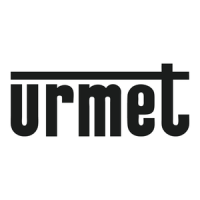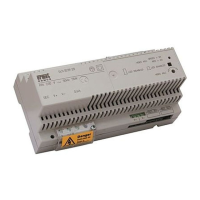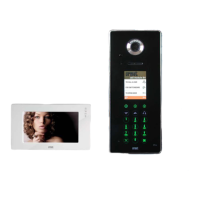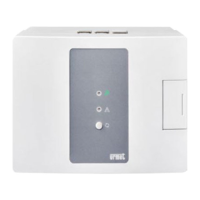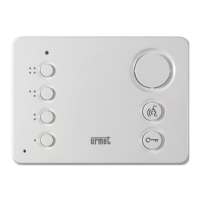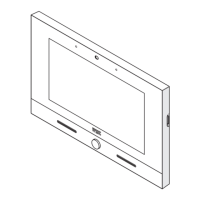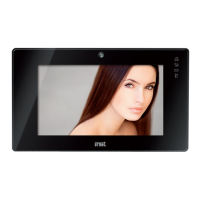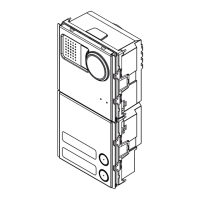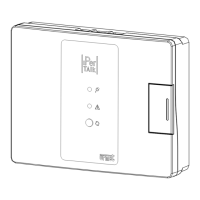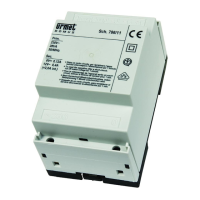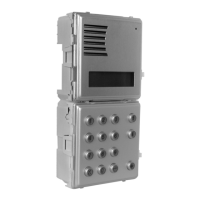Do you have a question about the urmet domus IPervoice and is the answer not in the manual?
Describes the system's external level framework using an IP-compatible network with CAT5 cabling.
Lists and describes fundamental and optional devices on the external IP network level.
Describes a special high-reliability solution for large systems using multiple IPervoice servers.
Discusses the two valid connection solutions for switchboards in a Multi-Server system.
Explains the importance of defining IP address ranges for effective system management in Multi-Server mode.
Details the main IPervoice service, allowing interaction with other functions and various installation models.
Outlines the primary functions of the video door phone service, including call code configuration and management.
Explains the concierge switchboard service managed by a dedicated software application.
Provides service for controlling passage openings via proximity keys or call modules.
Details on managing proximity keys, including validity, time bands, and anti pass-back features.
Prescribes using specific CAT5 cables and installation methods for the external level, avoiding direct burial.
Details cable laying in ducts for internal levels, suggesting avoiding co-location with 230V cables.
Introduces the Web-based Frontend application as the primary tool for system configuration.
Introduces a guided procedure for system configuring operations, simplifying initial setup.
Guides on entering system configuration parameters, including basic and advanced information for site identification.
Details the process of configuring IP/CAT5 gateways, including status, identification, and system structure data.
Explains the minimum required data for identifying and configuring IP Call Modules via the Startup Wizard.
Covers configuration for IP Video Door Units, requiring identification data for system integration.
Details the configuration steps for concierge switchboards, identifying their locations via MAC address.
Describes selecting and configuring video servers, including camera list management and input selection.
Explains the procedure for configuring IP key readers, including required data and device status.
Guides on configuring special decoders, detailing required data and system status.
Covers connecting VoIP devices, requiring preliminary registration to the SIP server for visibility.
Details advanced configuration parameters for IP call modules, grouped into user interface and special decoder sections.
Describes advanced configuration for IP video door units, similar to call modules but without graphic display.
Covers advanced configuration for concierge switchboards, defining competence areas and interactions with IP special decoders.
Details advanced access control using IP Modules and PIO Modules for managing doors and proximity readers.
Describes downloading configuration data to column devices via a mobile device using Bluetooth.
Covers the configuration of 4-user decoders, including association with blocks, stairs, and apartments.
Describes two modes for selecting apartments in the devices tree: by 4-user decoder or by floor.
Covers additional configuration data for apartments, including call forwarding and floor access.
Allows assigning unique door codes to residents for opening passages via call modules or IP key readers.
Details associating proximity keys to residents for opening passages, including validity and door selection.
Guides on adding or configuring IP apartments, linking them to floors and managing basic information.
Covers IPervoice server configuration settings, including timing, IP settings, and DHCP.
Details server configuration specifically for Multi-Server mode, including server status and operations.
Manages user rights and access for IPervoice FrontEnd, defining profiles and their capabilities.
Explains how to save system data on a PC using the Frontend's Backup and Restore function.
Guides on restoring configuration data from a previous backup using the Frontend's Backup and Restore function.
Allows installing new system application versions, requiring the upgrade file on a connected PC.
Explains how the system automatically updates IP devices after a server reboot, checking firmware consistency.
Details the process of upgrading IPervoice servers in Multi-Server mode, requiring manual restarts.
Lists minimum processor, RAM, disk space, video card, USB, Ethernet, Bluetooth, and browser requirements.
Guides on checking for previous installations, disabling antivirus/firewall, and enabling Active-X controls.
Details starting the installation software and following on-screen indications, requiring system administrator rights.
Covers adding and configuring new IP devices in offline mode or server mode, requiring device type and MAC address.
Details adding new IP devices via FrontEnd, selecting device type and MAC address for system identification.
Explains configuring column devices using the Stand Alone FrontEnd and Bluetooth interface.
Details selecting column devices from the tree and using Program/Read via BT buttons for data transfer.
Guides on identifying and pairing the Bluetooth programming interface (1039/56) with the host PC for the first time.
Explains how to check downloaded configuration parameters by reading data from the column device via Bluetooth.
Describes the system's external level framework using an IP-compatible network with CAT5 cabling.
Lists and describes fundamental and optional devices on the external IP network level.
Describes a special high-reliability solution for large systems using multiple IPervoice servers.
Discusses the two valid connection solutions for switchboards in a Multi-Server system.
Explains the importance of defining IP address ranges for effective system management in Multi-Server mode.
Details the main IPervoice service, allowing interaction with other functions and various installation models.
Outlines the primary functions of the video door phone service, including call code configuration and management.
Explains the concierge switchboard service managed by a dedicated software application.
Provides service for controlling passage openings via proximity keys or call modules.
Details on managing proximity keys, including validity, time bands, and anti pass-back features.
Prescribes using specific CAT5 cables and installation methods for the external level, avoiding direct burial.
Details cable laying in ducts for internal levels, suggesting avoiding co-location with 230V cables.
Introduces the Web-based Frontend application as the primary tool for system configuration.
Introduces a guided procedure for system configuring operations, simplifying initial setup.
Guides on entering system configuration parameters, including basic and advanced information for site identification.
Details the process of configuring IP/CAT5 gateways, including status, identification, and system structure data.
Explains the minimum required data for identifying and configuring IP Call Modules via the Startup Wizard.
Covers configuration for IP Video Door Units, requiring identification data for system integration.
Details the configuration steps for concierge switchboards, identifying their locations via MAC address.
Describes selecting and configuring video servers, including camera list management and input selection.
Explains the procedure for configuring IP key readers, including required data and device status.
Guides on configuring special decoders, detailing required data and system status.
Covers connecting VoIP devices, requiring preliminary registration to the SIP server for visibility.
Details advanced configuration parameters for IP call modules, grouped into user interface and special decoder sections.
Describes advanced configuration for IP video door units, similar to call modules but without graphic display.
Covers advanced configuration for concierge switchboards, defining competence areas and interactions with IP special decoders.
Details advanced access control using IP Modules and PIO Modules for managing doors and proximity readers.
Describes downloading configuration data to column devices via a mobile device using Bluetooth.
Covers the configuration of 4-user decoders, including association with blocks, stairs, and apartments.
Describes two modes for selecting apartments in the devices tree: by 4-user decoder or by floor.
Covers additional configuration data for apartments, including call forwarding and floor access.
Allows assigning unique door codes to residents for opening passages via call modules or IP key readers.
Details associating proximity keys to residents for opening passages, including validity and door selection.
Guides on adding or configuring IP apartments, linking them to floors and managing basic information.
Covers IPervoice server configuration settings, including timing, IP settings, and DHCP.
Details server configuration specifically for Multi-Server mode, including server status and operations.
Manages user rights and access for IPervoice FrontEnd, defining profiles and their capabilities.
Explains how to save system data on a PC using the Frontend's Backup and Restore function.
Guides on restoring configuration data from a previous backup using the Frontend's Backup and Restore function.
Allows installing new system application versions, requiring the upgrade file on a connected PC.
Explains how the system automatically updates IP devices after a server reboot, checking firmware consistency.
Details the process of upgrading IPervoice servers in Multi-Server mode, requiring manual restarts.
Lists minimum processor, RAM, disk space, video card, USB, Ethernet, Bluetooth, and browser requirements.
Guides on checking for previous installations, disabling antivirus/firewall, and enabling Active-X controls.
Details starting the installation software and following on-screen indications, requiring system administrator rights.
Covers adding and configuring new IP devices in offline mode or server mode, requiring device type and MAC address.
Details adding new IP devices via FrontEnd, selecting device type and MAC address for system identification.
Explains configuring column devices using the Stand Alone FrontEnd and Bluetooth interface.
Details selecting column devices from the tree and using Program/Read via BT buttons for data transfer.
Guides on identifying and pairing the Bluetooth programming interface (1039/56) with the host PC for the first time.
Explains how to check downloaded configuration parameters by reading data from the column device via Bluetooth.
| Type | Video Intercom |
|---|---|
| Technology | IP |
| Wiring | Ethernet |
| Video Compression | H.264 |
| Audio Compression | G.711 |
| Power Source | PoE (Power over Ethernet) |
| Mounting Type | Wall-mounted |
| Camera | Yes |
| Network Interface | 10/100 Mbps Ethernet |
